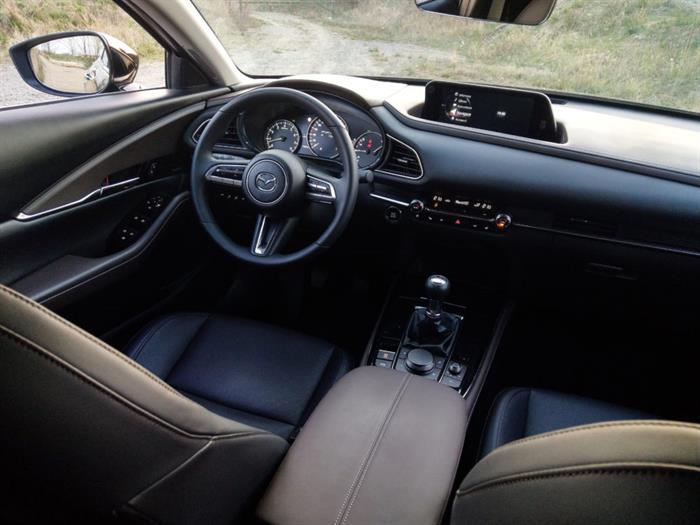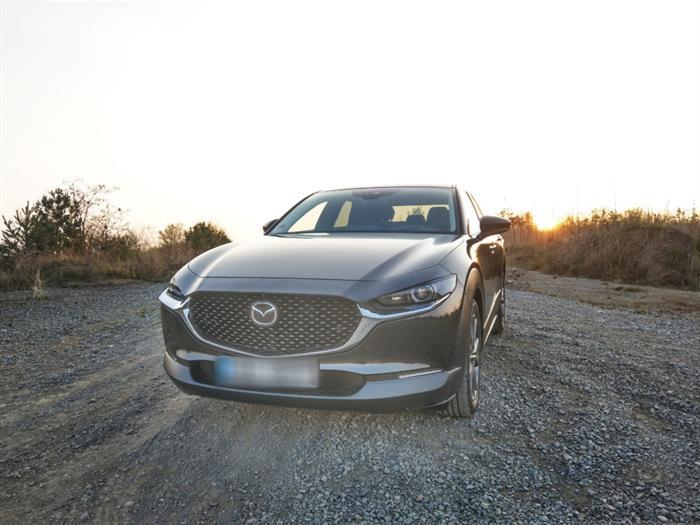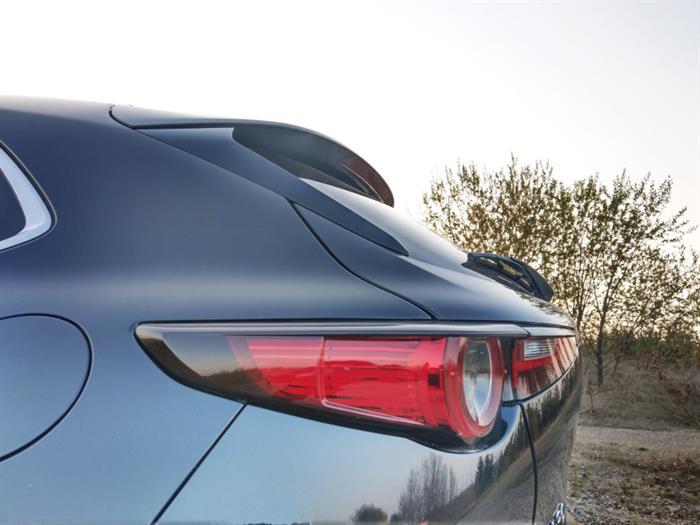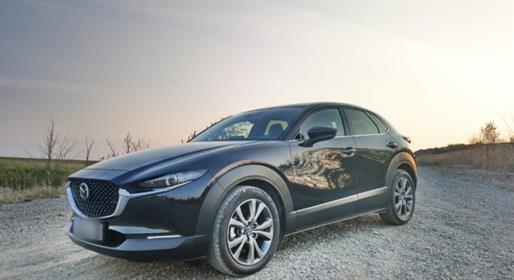After a long time, we have my favorite Mazda again. This time, however, it is a double premiere. The new CX-30 model, which has an innovative Skyactiv-X engine under the hood, passed our editorial test.
The Mazda CX-30 ranks between the CX-3 and CX-5 models in the automaker's portfolio. Thus, such an expanded range of offered cars will certainly make it easier for potential customers to choose their future car. The new CX-30 model is based on the Mazda 3, with which it shares many common components. However, the novelty is shorter in size and has a shorter wheelbase than the classic "three". However, it offers a more voluminous luggage compartment and, thanks to belonging to the crossover category, also more headroom.
We also have the innovative Skyactiv-X engine. This gasoline engine can work in a certain mode with a very lean mixture and then basically function similarly to a diesel engine.

Exterior
In terms of exterior design, the new CX-30 proudly adheres to the current signature of Mazda cars. The car thus has integral and relatively simple shapes. Of course, there is a significant overhang of the body in front of the front wheels, which contrasts with a small overhang in the rear section. The CX-30 complements its off-road ambitions and higher body structure with distinctive plastic edging. Its expressiveness was greatly suppressed in our tested car by the dark painted bodywork, in other color shades this protective element is applied much more prominently.
Unfortunately, with the CX-30 model, we have to forget about the massive and great-looking "C" column, which the 3 model (hatchback version) has. In this party, the "thirty" is noticeably more moderate. The front part, however, sticks to the excellent handwriting that the just-mentioned "troika" came up with in the past. Considerable ferocity and dynamism are inscribed in the distinctively cut and narrow front headlights. Of course, the front part must not be missing a bulky front mask. The already mentioned headlights emerge very elegantly from its chrome trim.
The rear part, like the concept of the whole car, is very calm, working with individual proportions and details. These mainly include the rear taillights, which feature an elegant circular motif. This whole part is already quite traditionally underlined by a pair of chrome exhaust tips.
In terms of exterior design, the new Mazda CX-30 is designed fully in the spirit of the automaker's current signature, which is definitely imaginative and I like it very much.

Interior
The interior, mainly the dashboard, is well known to me from the previously tested Mazda 3. Its shapes offer very simple and elegant lines, and its orientation towards the driver is clearly visible.
The instrument panel in front of the driver does not protrude from the dashboard in any way and is successfully integrated into it. There are classic circular indicators with a tachometer, speedometer and temperature and fuel level indicators. The central circular speed indicator received a digital display that very successfully simulates its analog environment, and also offers an alternative display of the car during active lane control.
The upper part of the continuous dashboard is dominated by the on-board infotainment display. It is an 8.8-inch wide display that successfully makes us forget about previous small, protruding from the dashboard, displays with poor graphics. The graphic environment of the new infotainment is very simple and, thanks to the control using the circular controller, which is located within the central tunnel, also very simple .
I have to praise the traditionally praised operation of the six-speed manual transmission selector in the new CX-30 as well. Here, Mazda has been setting a very high bar for its models for a long time.
Another very pleasant element of the car's interior is the multifunctional steering wheel itself. It has an unusually subtle crown and an attractive arrangement of the individual controls.
The spaciousness of the interior is certainly not lacking, the seats themselves are comfortable and thanks to the higher body structure, the CX-30 has enough headroom.
In the context of the Model 3 , the luggage compartment of the car was significantly increased in volume. The basic volume is 430 liters and offers 1406 liters with the backs of the rear seats folded down.
The traditional effort to connect the driver and the car with the help of excellent ergonomics continues to work perfectly in the new CX-30 model.

"Revolutionary" Skyactiv-X engine
The portfolio of engines offered for the CX-30 model offers four possible variants. Three are gasoline and one diesel. Gasoline engines are represented by these variants, they are the Skyactiv-G 122 (122 horsepower) and Skyactiv-G 150 (150 horsepower), another gasoline engine is the Skyactiv-X 180 (180 horsepower) we are currently testing. The diesel variant is labeled Skyactiv-D 116 and offers 116 horsepower.
But let's go to the Skyactiv-X variant we tested, it is available in all possible variations. You can therefore have it both with the drive of only the front axle and with the drive of both axles, and then with a classic manual transmission or with an automatic transmission.
Basically, Skyactiv-X is an engine that, as I mentioned in the introduction, can work with a very lean mixture. In part, its operation is thus close to the principle of operation of a diesel engine.
This naturally aspirated four-cylinder with a high compression ratio works both in classic petrol and in combined (partially "diesel") mode.
The SPCCI (Spark Controlled Compression Ignition) system works simply as follows: primarily an extremely lean mixture enters the combustion chamber of the cylinders, which cannot be ignited with a spark plug, at the end of the compression phase, another small amount of fuel is injected near the spark plug, then this mixture is ignited and igniting the remaining lean mixture in the cylinder. The fuel should thus burn much faster, the engine performance should be higher and its emissions lower.
When maximum power is needed, or in the extreme opposite case, the engine operates in classic petrol mode. Switching between classic mode and SPCCI mode is completely automatic. Mazda claims that in "combined" mode the car moves very often, resulting in up to 80% of driving time.
The Mazda CX-30 also has mild-hybrid technology, which, thanks to the integrated starter/generator, uses recuperation and stores energy in the battery, which is then used to run on-board systems.
And to make matters worse, the Skyactiv-X engine is also equipped with a small compressor that helps the SPCCI system provide enough air to create a lean mixture.
In reality, the performance of the innovative Skyactiv-X engine is very quiet and refined, similar to the classic Skyactiv-G gasoline atmospheres. The engine will also offer maximum power (180 hp) at 6,000 rpm and peak torque (224 Nm) at 3,000 rpm. So even this engine clearly loves revs, and you simply need to rev it to drive briskly.
The CX-30 definitely has no problem with dynamic driving, it is helped by a great, rather stiffer chassis, excellent steering and well-functioning ergonomics inside the car. The six-speed manual also contributes to a great driving experience, which is well graded and also has a great gear shift.
One of the positives of this motorization should also be its economy. Unfortunately, the CX-30 didn't perform well during the week-long test, as I averaged around 6.5 liters of fuel per 100 km.

In conclusion
The Mazda CX-30 is currently offered from CZK 614,900 including VAT. This is the basic Skyactiv-G122 gasoline, which has a manual transmission and front axle drive. The basic Skyactiv-D116 diesel starts at CZK 663,900 including VAT, again with a manual and front axle drive only.
You can buy the basic CX-30 with the innovative Skyactiv-X 180 GT engine from CZK 690,900 including VAT. On the other hand, the top variant of this motorization with automatic transmission and drive on both axles is available from CZK 847,900 including VAT.
The Mazda CX-30 is a novelty that I have to rate positively in terms of exterior design. The car is consistently designed in the car company's current design direction, which I simply like very much. I praise the interior for its precise processing and traditionally excellent ergonomics. Mazda should also be praised for its pricing policy and reasonable purchase prices.
And what about the innovative Skyactiv-X engine? Personally, I didn't have the slightest problem with its performance, the engine is very quiet and refined, and it only shows its dynamics clearly at higher revs. Its weakest point for me during the editorial test was its consumption. So let's be surprised, what future awaits this "revolutionary" motorization.



























